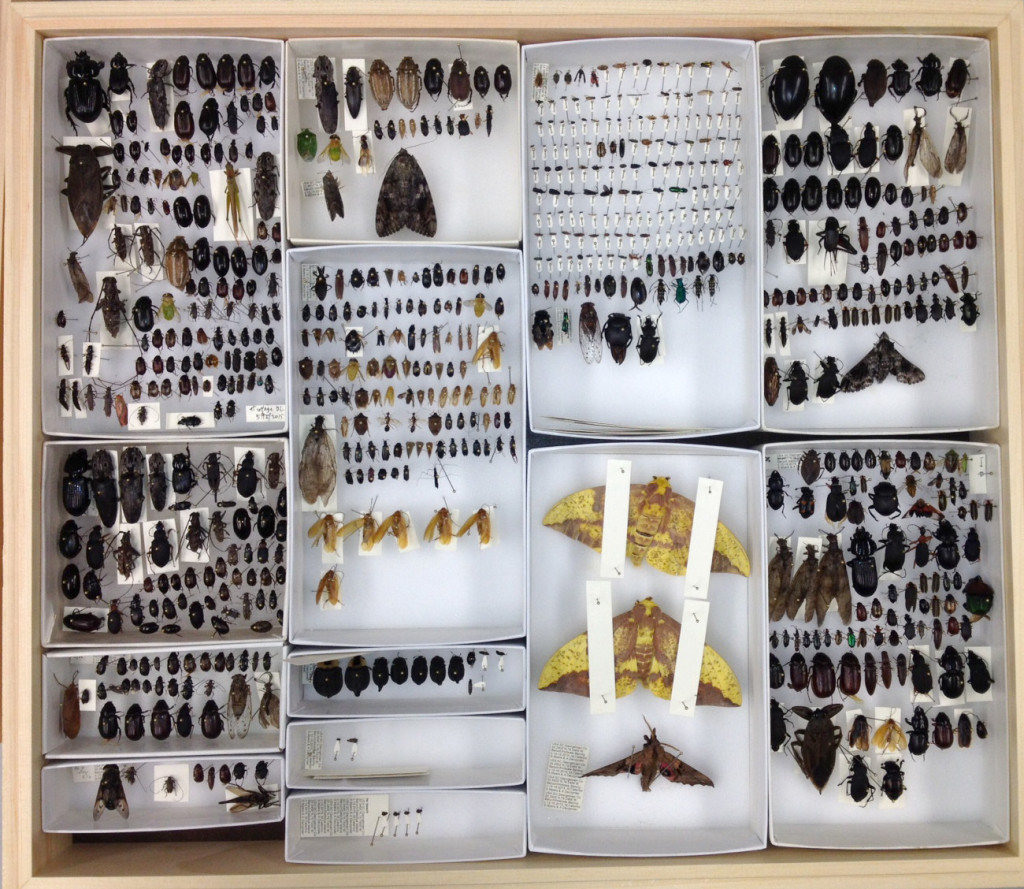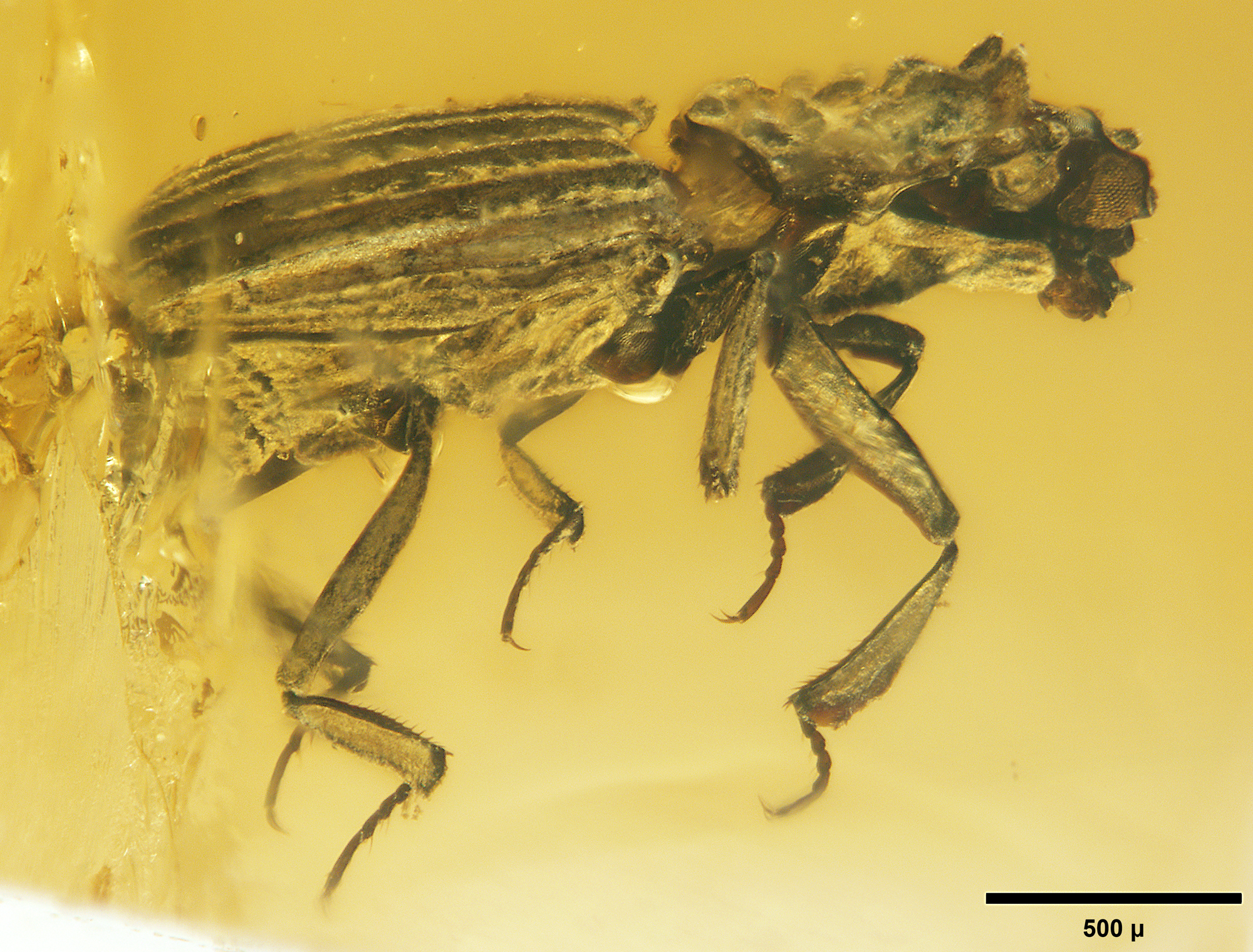a clue in amber
story by Jemma Everyhope-Roser
images courtesy of Michael Caterino
To protect the small amber piece with the tiny fossil beetle, research partners at Stuttgart State Museum of Natural History in Germany embedded it in a polyester resin, which was then ground and polished with wet silicon carbide abrasive papers, before these microphotographs were taken.
In a locked room at a museum, the 99-million-year-old beetle rests peacefully, its tiny two-millimeter-long body encased in pale golden amber. The only sign of its death struggles may be the bubbles warping fossilized tree sap. No one can yet put a name on this new J. Doe, its sex undetermined.
A special consultant in the international entomology community enters the scene, a man who regularly undertakes “intensive field surveys to discover more cryptic and elusive species” and whose attention to detail, which could shame Sherlock Holmes, has led him to identify over 400 new beetle species.
Michael Caterino, an expert with twenty years of experience, serves as the Morse Chair of Entomology and directs the Clemson University Arthropod Collection.
As beetles are among the most successful and diverse group of animals on the planet, researchers like Caterino tend to specialize. Caterino focuses his research on one family of beetle, Histeridae, which has over 4,000 species, and he’s been known to get his hands dirty when chasing his specimens down. His blog, Southeastern Beetles, gives testimony not only to his discoveries but also to his fieldwork, his pursuit of suspected new species. But to investigate the special case of the ninety-nine-million-year-old beetle, Caterino had to do some real detective work and break out the magnifying glass—or, to be more accurate, the zoom.
“In most cases, I wouldn’t consider photography adequate for my research,” Caterino says. But in this case, working with research partners Karin Wolf-Schwenninger and Günter Bechly of the Stuttgart State Museum of Natural History in Germany, he directed the photographs of the specimen, ensuring the capture of every necessary angle, so he’d have accurate evidence on which to base his conclusions.
Using these research-quality images, Caterino examined the insect from its head to its toes, or, as Caterino would say, from its “frontal disk” to its “protarsal claws.”

The Clemson University Arthropod Collection (CUAC), led by Caterino, consists of 1.3 million specimens. Over one million of those are wet, preserved in alcohol, and about 200,000 are dry and pinned.
Ever wondered what an entomological repository does? A lot, it turns out. CUAC is:
• a permanent repository for research specimens;
• a reference collection for identifying important samples sent in from around the state;
• a historical record of changing biota, possessing a variety of specimens collected over the course of this past century;
• and an educational resource, with displays and off-campus demonstrations.
Among the first insect collections to begin electronically cataloguing its holdings, CUAC has a searchable database with county-level distributional data.
The mystery he hoped to solve?
Not its cause of death. That was transparent. The beetle had fallen victim to its preserver, the tree resin that captured it, encoated it and fossilized into amber.
No, Caterino sought to uncover a greater mystery. How has Histeridae become the successful group it is today? Why and how has it come to be so diverse? What is its story?
“I try to put together evolutionary trees and see how they have evolved over time,” Caterino explains. “That’s why the discovery of this fossil was so exciting to me. It provides tangible evidence to back up some previous inferences, but it also reveals some surprises.”
Phylogeography, the study of genetic variation within species, fascinates Caterino because it can reveal the evolutionary processes, like the response of species to geological and climatic events, that drive diversification and speciation. But even though huge advances recently in DNA technologies and visualizations provide unprecedented levels of data, for this particular specimen Caterino had to rely on good, old-fashioned observation.
“Unfortunately, ancient ecology is not so easily observed, even in excellent fossils,” Caterino says. Even so, this beetle has something to offer: “In determining evolutionary relationships by looking only at modern species, scientists are essentially guessing what the ancestors must have looked like. But in this case, we are able to see the ancestor.”
That’s why this specimen, so perfectly preserved in amber, may be critical to understanding the beetle family’s early history. “We can see all the details of the external sculpturing of the wing covers and the head,” Caterino explains. “We can see the mouth parts, which enable us to predict that this was a predator much like its modern relatives.”
Historically, the understanding of the beetle’s family origins has been obscure, at least partly due to a sparse and poorly documented fossil record. Only one other well-described Mesozoic specimen from the same period, the Middle Cretaceous, survives. That specimen is completely different from this one. “This is a new fossil genus species that we’ve called Cretonthophilus tuberculatus,” Caterino says. “Cretonthophilus indicates that it’s a Cretaceous relative of the modern-day genus Onthophilus, while tuberculatus refers to the large bumps on the sides of its thorax.”
But what’s especially interesting about the discovery of two very different specimens is that it suggests that the Histeridae beetle family may’ve originated a lot earlier than previously thought: It would’ve needed time to diversify so radically. So finding a second beetle, so different from the first, changes everything.
Summing up the evidence that this clue encased in amber hints at, Caterino says, “It has a lot of tantalizing characteristics that we hypothesized early members of this family had. But we no longer have to guess. Now we can confirm.”



